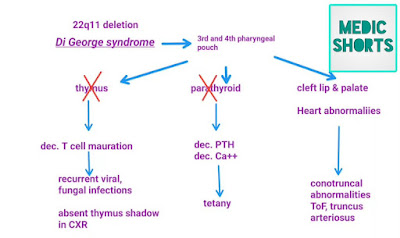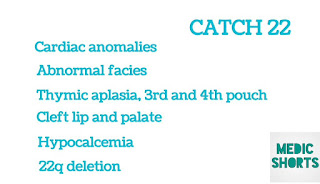ⒸPathologynuggets. Notes to review for medical students, residents, and doctors.
Hello, welcome to our new blog post.
Today, we are quickly reviewing high yield concepts of Di George Syndrome.
Please read till the end of the blog for a bonus mnemonic for this important topic!
DiGeorge syndrome, also known as 22q11 deletion syndrome, is a genetic disease caused by deletion of chromosome 22 and results in impairment of the third and fourth pharyngeal pouches.
Therefore, the structures developing from 3rd and fourth pharyngeal pouches are affected in this disease.
Now lets' look at the structures affected,
One of the structures affected is the Thymus gland as you know the thymus develops from the inferior part of 3rd pharyngeal pouch.
Next important structures affected are parathyroid glands, because as you all know the inferior parathyroids develop from superior part of 3rd pouch, and superior parathyroids develop from superior part of 4th pouch.
Therefore, the affected structures are thymus and parathyroid.
Other associated abnormalities are cleft lip, cleft palate and heart abnormalities
Thymus gland is the site of T-cells maturation, which plays important part in immunity. Thus, if thymus gland is affected, there is decreased t cell maturation.
When parathyroid gland function is abnormal, there is decreased synthesis of parathyroid hormone and decreased serum calcium level.
Thus, a child with DiGeorge syndrome suffers from recurrent viral and fungal infections. One of the important findings in Digeorge syndrome is absence of Thymic shadow in chest x ray.
Similarly due to decreased serum calcium you can see muscle spasms or tetany.
And lastly, as mentioned earlier, you may also find cleft lip, cleft palate or heart abnormalities like tetralogy of Fallot, truncus arteriosus, etc.
Thank you for reading to the end of the blog. We hope this helps you in quick review of DiGeorge Syndrome.
As we promised at the start of the blog, here is a bonus mnemonic for you to remember the features of DiGeorge syndrome,
which is "CATCH-22"
Cardiac malformation, Abnormal face, Thymic Hypoplasia, Third and fourth pouches, Cleft palate, Hypocalcemia, 22q microdeletion
Have a great time!
You can also check below for the video summary of this blog.
See you in next blog post where we bring to you easy, high yield quick review of another clinical concept. Leave your comment below if you have any suggestions.
Thank you!






Comments
Post a Comment